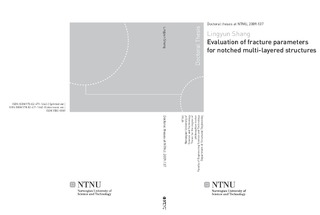| dc.contributor.author | Shang, Lingyun | nb_NO |
| dc.date.accessioned | 2014-12-19T11:58:05Z | |
| dc.date.available | 2014-12-19T11:58:05Z | |
| dc.date.created | 2009-11-20 | nb_NO |
| dc.date.issued | 2009 | nb_NO |
| dc.identifier | 280126 | nb_NO |
| dc.identifier.isbn | 978-82-471-1662-3 (printed ver.) | nb_NO |
| dc.identifier.isbn | 978-82-471-1663-0 (electronic ver.) | nb_NO |
| dc.identifier.uri | http://hdl.handle.net/11250/236420 | |
| dc.description.abstract | For the last three decades, the field of MEMS (Micro-Electro-Mechanical Systems) has emerged to a technology with significant potential. Re-entrant sharp corners or notches have increasingly appeared in MEMS fabrication and packaging. Due to the stress concentration and/or elastic mismatch at re-entrant corner, the initiation of failure at sharp corner or at free edges in multi-material systems often occurs. Hence, how to characterize the singular stress fields and the interface strength at these failure sites becomes very important.
This dissertation consists of six chapters and three papers. The background of this problem is presented in Chapter 1. In Chapter 2, MEMS technology and useful online resources are provided. Anisotropic elasticity theory including Stroh formalism is briefly addressed in Chapter 3. The focus of Chapter 4 is on distinction of notch mechanics from classical fracture mechanics. Chapter 5 gives an overview of the three appended papers. Conclusions of this study are summarized in Chapter 6 along with recommendations for future work.
Finally, three papers are appended investigating various aspects of multi-layered notched problem. The specific structures we have studied are popular in MEMS. The H-integral approach, as a tool to derive stress intensity factors for notches and cracks, has been performed in all the papers. This path independent contour integral method is based on a combination of Betti's law, Stroh’s formalism, finite element results and asymptotic analysis with a complementary field. Plane strain conditions are assumed in all modeling. Linear elastic finite element analyses are performed with ABAQUS (Finite element code). A good agreement between numerical predictions obtained from the H-integral method and the detailed FE results has been achieved, showing the applicability of this approach.
Paper I focuses on the fracture behavior of two types of triple stacks specimens with a sharp corner. Standardized numerical formulae of the dimensionless stress intensity factor are proposed for two typical specimens, and the dependence of geometry is analyzed. The effect of glass thickness on stress intensity is explored for anodic-bonded Si-Glass-Si triple stacks. Distinct failure criteria for sharp notches have been qualified and three different approaches have been compared and quantified. The influencing factors and uncertainties for their applicability of critical stress intensity factors have also been discussed. Furthermore, the deviation between a fine mesh and a coarse mesh has been quantified.
Paper II investigates the weak singularity problem at free edges in multi-layered structural components. In Paper II, the effects of elastic constants of various material combinations on the weak singularity at free edges are analyzed. Using the H-integral approach, the effects of elastic mismatch parameters, the bond area and the thickness of the thin metal layer on the stress intensity factor are quantified. The relationship between the valid range of the K -dominated field and the thin-film thickness is then demonstrated. Besides, the competition of crack initiation between the free edge interface (180º opening angle) and a 90º notch interface in a generic specimen is investigated, in order to find out which is the prevailing failure mode. Comparison between isotropic Si and anisotropic Si substrate is also illustrated.
Paper III concentrates on a general notch problem and presents the computational procedure for obtaining the stress intensity factor in a flow chart. Three critical issues are addressed to clear up some confusion in the notch mechanics: the interpretation of the eigenvalue equation, the definition of stress intensity factors, and the effect of the outer contour location on H-integral evaluations.
| nb_NO |
| dc.language | eng | nb_NO |
| dc.publisher | Norges teknisk-naturvitenskapelige universitet, Fakultet for ingeniørvitenskap og teknologi, Institutt for konstruksjonsteknikk | nb_NO |
| dc.relation.ispartofseries | Doktoravhandlinger ved NTNU, 1503-8181; 2009:137 | nb_NO |
| dc.relation.haspart | Shang, LY; Zhang, ZL; Skallerud, B.. Fracture of anodic-bonded silicon-thin film glass-silicon triple stacks. Engineering Fracture Mechanics. (ISSN 0013-7944). 75(5): 1064-1082, 2008. <a href='http://dx.doi.org/10.1016/j.engfracmech.2007.04.030'>10.1016/j.engfracmech.2007.04.030</a>. | nb_NO |
| dc.relation.haspart | Shang, LY; Zhang, ZL; Skallerud, B. Evaluation of fracture mechanics parameters for free edges in multi-layered structures with weak singularities. International Journal of Solids and Structures. (ISSN 0020-7683). 46(5): 1134-1148, 2009. <a href='http://dx.doi.org/10.1016/j.ijsolstr.2008.10.018'>10.1016/j.ijsolstr.2008.10.018</a>. | nb_NO |
| dc.relation.haspart | Shang, LY; Zhang, ZL; Skallerud, B.. Comments on the evaluation of the stress intensity factor for a general re-entrant corner in anisotropic bi-materials . Engineering Fracture Mechanics. (ISSN 0013-7944). 76(9): 1373-1379, 2009. <a href='http://dx.doi.org/10.1016/j.engfracmech.2009.01.012'>10.1016/j.engfracmech.2009.01.012</a>. | nb_NO |
| dc.title | Evaluation of fracture parameters for notched multi-layered structures | nb_NO |
| dc.type | Doctoral thesis | nb_NO |
| dc.contributor.department | Norges teknisk-naturvitenskapelige universitet, Fakultet for ingeniørvitenskap og teknologi, Institutt for konstruksjonsteknikk | nb_NO |
| dc.description.degree | PhD i konstruksjonsteknikk | nb_NO |
| dc.description.degree | PhD in Structural Engineering | en_GB |
